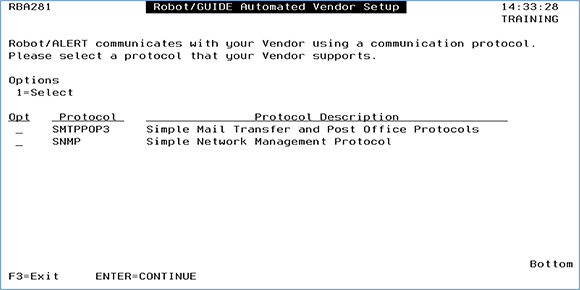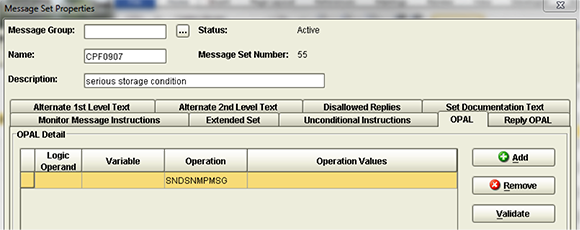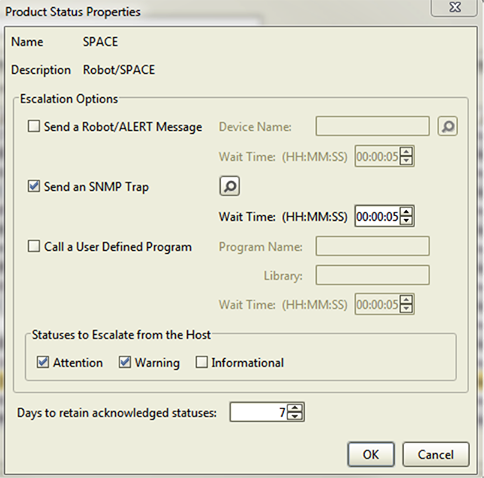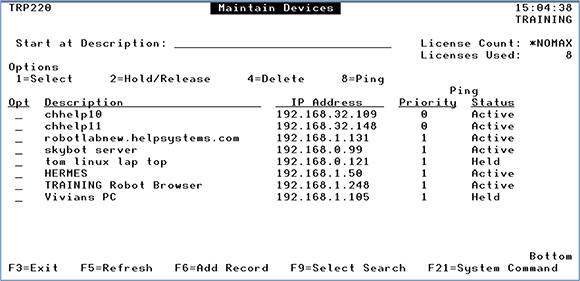Is your SNMP enterprise management solution busting your budget? Do you even have a trap-monitoring product in place? Learn how Robot products can double as an inexpensive solution for SNMP management.
SNMP (or simple network management protocol) is the network management and monitoring standard in the IT industry. Many devices—such as switches, routers, printers, and servers—have this protocol built in. SNMP is also used as one of the notification and escalation methodologies available in Robot products. Take as example a disk failure message or application message waiting and intercepted by Robot, or issues regarding a Robot-submitted job that ended abnormally. Typically, these events (SNMP traps) are directed to a central SNMP manager, which may be a central, corporate-wide, problem-ticketing system or management console. They can also be directed to Robot if you do not have a trap-monitoring product already in place (see Robot/TRAPPER below).
In general, there are two pieces to configuring SNMP:
- Designate a host system to receive the trap information and define this on each device sending SNMP traps.
- Give information to the SNMP manager as to how to interpret the data—i.e., a management information base (MIB) file.
Let's take a look at the options for using SNMP in your Robot implementation.
Robot/ALERT
Many of our customers use Robot/ALERT to escalate issues, including message monitoring (Robot/CONSOLE), automated jobs (Robot/SCHEDULE), or even disk space analysis (Robot/SPACE). Almost all of our products use Robot/ALERT as the escalation mechanism to alert you that there may be an issue or an exception that has not been automated.
To configure Robot/ALERT to use SNMP, you configure and use an SNMP vendor setup. This does require that IBM i SNMP be turned on (CHGSNMPA) and set up with the appropriate IP address for your SNMP manager. The MIB file is located at RBTSYSLIB/RSLMIB.RBAPGMIB and should be FTPed or copied to your SNMP manager software so that the trap data can be properly interpreted.
The Robot/ALERT SNMP type device can then be specified on any of our products that allow that type of notification.

Figure 1: These IP protocols are available in Robot/ALERT.
Robot/CONSOLE
Many of you have used Robot/CONSOLE message sets to automate messages and escalate issues. OPAL (OPerator Assistance Language) in Robot/CONSOLE Message Sets contains an SNMP operation called SNDSNMPMSG. This operation takes the message information and sends it off to the same SNMP manager defined in the SNMP attributes of your IBM i (CHGSNMPA) directly. This allows you to be more selective when choosing which issues to escalate with SNMP and which to email using the Robot/ALERT interface.
The MIB file is located at RBTSYSLIB/RSLMIB.RBCSMMIB and should be FTPed or copied to your SNMP manager software.

Figure 2: The Robot/CONSOLE message set looks like this.
Robot/NETWORK
Robot/NETWORK is yet another option for you to take advantage of the SNMP protocol, plus it allows the use of two-way traps. Issues can be escalated from our Robot products and consolidated in the Robot/NETWORK Status Center. Issues escalated from each of the Robot products, including QSYSOPR messages intercepted by Robot/CONSOLE, can be escalated via three methods: Robot/ALERT, SNMP, or through a user program (see Figure 3). This SNMP path does not require the use of the IBM i SNMP server.
The MIB file is located at RBTSYSLIB/RSLMIB.RNHEMMIB.

Figure 3: SNMP provides escalation in Robot/NETWORK.
Robot/TRAPPER
Robot/TRAPPER is an add-on for Robot/CONSOLE that allows you to ping network devices (see Figure 4) and accept incoming traps from your network. Essentially, the combination of Robot/CONSOLE and Robot/TRAPPER becomes your SNMP trap manager solution! In this case, you would configure the SNMP manager IP address as that of your IBM i. Then, import the MIB file into Robot/TRAPPER so that it can properly digest the incoming SNMP traps. Robot/TRAPPER then converts the traps into messages, which are placed into the Robot/TRAPPER Message Center in Robot/CONSOLE, where they can be automated and escalated just like any other IBM i message that you already know how to automate. You could even escalate and consolidate them to the Robot/NETWORK Status Center!

Figure 4: Here's an example of the Robot/TRAPPER Monitored Devices status screen.
Given the many options that Robot has for working with SNMP, it's easy to incorporate IBM i operations into your corporate network management model. If your business is more IBM i-centric, try using Robot as the SNMP manager in your data center. Start today by requesting a free, 30-day trial of Robot/CONSOLE and Robot/TRAPPER.












 Business users want new applications now. Market and regulatory pressures require faster application updates and delivery into production. Your IBM i developers may be approaching retirement, and you see no sure way to fill their positions with experienced developers. In addition, you may be caught between maintaining your existing applications and the uncertainty of moving to something new.
Business users want new applications now. Market and regulatory pressures require faster application updates and delivery into production. Your IBM i developers may be approaching retirement, and you see no sure way to fill their positions with experienced developers. In addition, you may be caught between maintaining your existing applications and the uncertainty of moving to something new. IT managers hoping to find new IBM i talent are discovering that the pool of experienced RPG programmers and operators or administrators with intimate knowledge of the operating system and the applications that run on it is small. This begs the question: How will you manage the platform that supports such a big part of your business? This guide offers strategies and software suggestions to help you plan IT staffing and resources and smooth the transition after your AS/400 talent retires. Read on to learn:
IT managers hoping to find new IBM i talent are discovering that the pool of experienced RPG programmers and operators or administrators with intimate knowledge of the operating system and the applications that run on it is small. This begs the question: How will you manage the platform that supports such a big part of your business? This guide offers strategies and software suggestions to help you plan IT staffing and resources and smooth the transition after your AS/400 talent retires. Read on to learn:
LATEST COMMENTS
MC Press Online